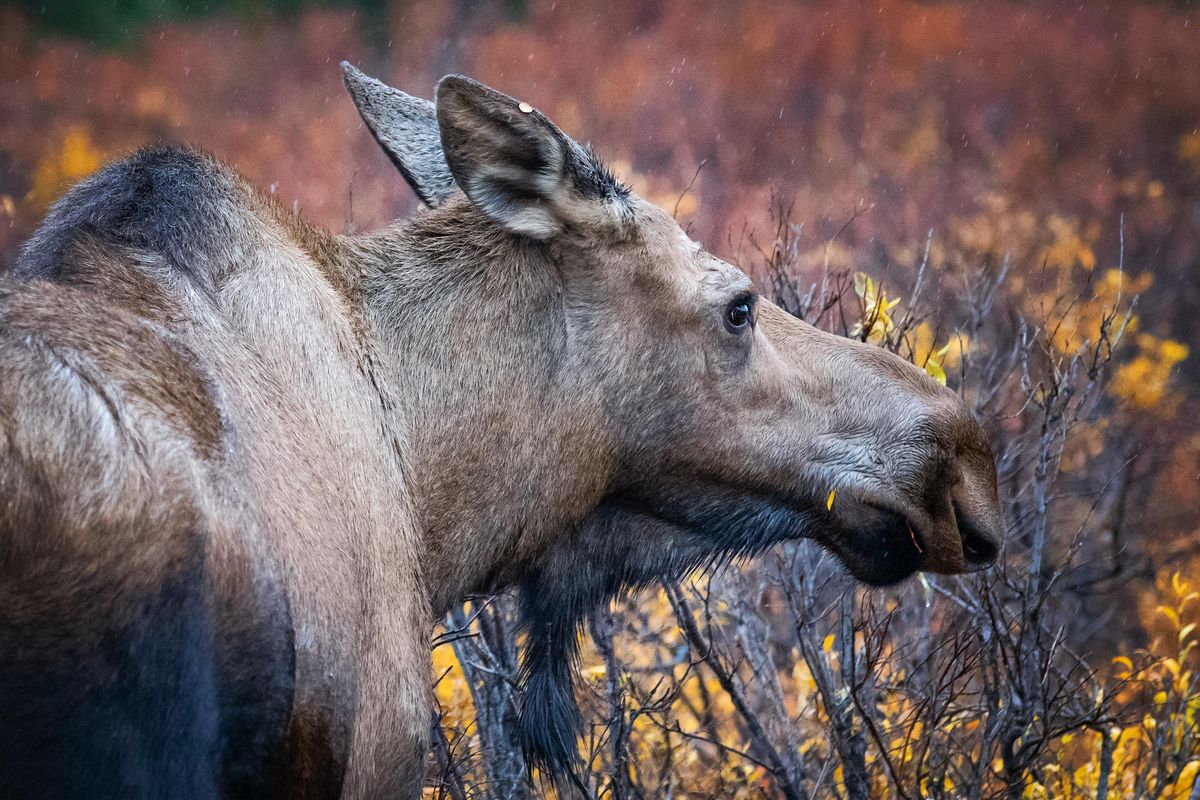Colville photographer wins coveted Denali Road Lottery spot

It all began with a Facebook post. As a nature photographer, a stunning image of a grizzly sow and cubs crossing the tundra in a snowstorm caught my eye. The photo had been taken by a Denali Road Lottery winner. My curiosity was piqued.
In the 1970s, heavy park traffic created crowd and wildlife management challenges, so officials limited private vehicles to the first 15 miles of the 92-mile Denali National Park road during tourist season. The rest of the park road was accessible only by bus. Postseason, private vehicles could still go through, but soon 2,000 cars per day were making the trip.
So the Denali Road Lottery was born. When the season closes in mid-September, the park reopens for five days, allowing people with permits to drive through the entire park. One day is military appreciation day. The other four days are for road lottery winners, who can drive the entire park road in their private vehicle with passengers. Tickets are sold in the spring, one per person, for $15. Four hundred winners are drawn for each lottery day. The odds of winning are around 1 in 8. Surprisingly, I was one of the lucky winners. We were headed to Alaska for an adventure.
And what an adventure it was. We came back awed, educated, even more appreciative of the treasure that is the national park system.
The 2 1/2-hour drive from Fairbanks to the park was awash in golden fall color. We claimed our lottery pass the afternoon before our lottery day, then drove the first 15 mile section of the park road.
It was clear that we were in a different land. Signs cautioned: “Sled dogs in training” or “Stay on roadway. Bull moose in rut.” We soon encountered several cars watching a cow moose and two calves grazing along the roadway. Huge in comparison to the moose in Northeast Washington, the cow was larger than the bulls at home. Moose in this park can be up to 7 feet tall. They made their way onto the road, weaving between the cars. This first sighting whet our appetites for the day to come.
An early bird I am not, but there are some things that will get me out of bed at the crack of dawn. Our golden ticket into the park was one of them. The alarm buzzed at 4:30 a.m., and we were at the entrance to the park about 15 minutes before 6, behind a handful of cars. The park lets cars through in groups, and we were in the first group. After an hour of following tail lights in the dark on the gravel road, with the rising sun we began to see the landscape of the park. Cars started stopping for photos and vehicles became spaced farther apart.
Soon, we were on our own in a strange land. In one direction, it appeared like a moonscape. In another direction was a broad expanse of tundra in various autumn hues, with sporadic black spruce popping up among the shorter vegetation. A tapestry of autumn color. Jagged, snow-capped peaks jutted up into the sky in the distance, rays of sunshine shining through the clouds, illuminating the mountaintops. Breathtaking views in every direction.
The Grand Poobah of the mountain range is the 20,310-foot Denali, a peak that dwarfs Mount Rainier in Washington. The name has changed over the decades, but in 2015 it was renamed to its original Athabascan name of Denali, meaning, “The High One.” Surrounded in clouds more than 80 percent of the time, we weren’t destined to see the mountain that day. But there were other sights in store.
Our first grizzly sighting was just after 8. A large adult descended a hillside, eating while walking along a gravel bed, then disappeared into a draw. We spotted a sow grizzly and two cubs quickly descending a hillside heading away from the draw. They entered the roadway, walking alongside several cars whose occupants were visibly excited at this close encounter.
A ranger diverted the bears off the roadway using a truck. Watching them ascend the mountain in the dramatic morning light with mist rising above them was a magnificent sight and a favorite memory of the trip. These massive creatures appeared small on the landscape, giving a sense of the vastness of this place.
Snow-white Dall sheep dotted the mountainsides. A desire to preserve them prompted naturalist Charles Sheldon to seek park status for the area in the early 1900s.
Caribou grazed in the distance. Trumpeter swans fed in glassy ponds reflecting the brilliant colors of autumn on their surface. Ptarmigan along the road made us bust out laughing at their comical bird call.
Just after exiting, as the daylight faded, we saw the largest bull moose I have seen, grazing near the roadside. His antlers were solid planks at least 3 feet high. He was magnificent.
We left the park exhilarated, tired, starving and in a car covered with mud. Food supplies run low postseason. If you are lucky enough to get a road lottery ticket, stock up before coming to the park.
The next morning, we returned to the spot where we’d seen the enormous bull moose. We spotted him with five cows on the hillside about one-half mile away. Even when he laid down to rest, we could easily spot him as sunlight reflected off of his huge paddles. Two smaller bulls and another cow were about 300 yards to the east, the bulls halfheartedly dueling.
People stopped to watch with us, giving us a chance to talk with travelers of all ages from Finland, Marrakesh, Scotland, Canada and the U.S. We exchanged stories of our experiences in Denali. Despite age, language and cultural differences, we shared a common bond –our love of this place, and the wonder of it all.